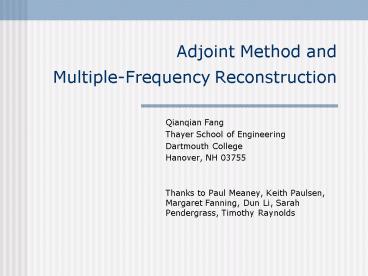Adjoint Method and MultipleFrequency Reconstruction - PowerPoint PPT Presentation
1 / 27
Title:
Adjoint Method and MultipleFrequency Reconstruction
Description:
Thanks to Paul Meaney, Keith Paulsen, Margaret Fanning, Dun Li, Sarah ... Definition: Independent discretization for state space and parameter space and ... – PowerPoint PPT presentation
Number of Views:131
Avg rating:3.0/5.0
Title: Adjoint Method and MultipleFrequency Reconstruction
1
Adjoint Method and Multiple-Frequency
Reconstruction
- Qianqian Fang
- Thayer School of Engineering
- Dartmouth College
- Hanover, NH 03755
- Thanks to Paul Meaney, Keith Paulsen, Margaret
Fanning, Dun Li, Sarah Pendergrass, Timothy
Raynolds
2
Outline
- Generalized Dual-mesh Scheme
- Adjoint formulation for dual-mesh
- Graphical interpretations
- Formulations
- Comparisons with old method
- Multiple-Frequency Reconstruction Algorithm
- Description of dispersive medium
- How it works (animation)
- General form for dispersive media
- Time-Domain Reconstruction Algorithm
- Results
- Conclusions and prospects
3
Dual-mesh - Math Form
- Definition Independent discretization for state
space and parameter space and the mapping rules
between the two sets of base functions. - Rf is called forward space, discretized by basis
- Rr is called reconstruction space, discretized by
basis Mostly, we have - Single-mesh/Sub-mesh schemes are special cases of
dual-mesh
4
Dual-mesh cond.
- Field values are defined on forward mesh
- Properties defined on reconstruction mesh
- So that
- Field on recon. mesh need to interpolate from
forward mesh - Properties on forward mesh need to interpolate
from recon mesh - Mapping
5
Dualmesh-Examples
2D FDTD forward mesh 2D order-2 recon. mesh
2D FEM forward mesh 2D order-1 recon. mesh
6
Jacobian Matrix
Provide the first order derivative information
Sensitive Coefficient
7
(No Transcript)
8
Formulation
Denoted as perturbation source
J1 E2 J2 E1
J2
J1
E1
E2
Reciprocal Media
9
Comparison
Old
New
Field generated by Js
Strength of auxiliary source, can be 1
Field generated by Jr
Very sparse matrix Geometry related only
Replace matrix inversion with matrix
multiplication
10
Computational Cost
- Computational cost for Sensitive Equ. Method
- For each iteration
- Solving the AXb for (NsNsNc) times, where
- Ns Source number
- Nc Parameter node number
- Computational cost for Adjoin method
- For each iteration
- Solving the AXb for (NsNr) times, where
- Ns Source number
- Nr Receiver number
- When using Tranceiver module, only Ns times
forward solving is needed. - Which is 1/(Nc1) of the time using by sensitive
equation method
11
Multiple Frequency Reconstruction Algorithm
- Ill-posedness of the inversion problem due to
insufficient data input and linear dependence of
the data.- rank deficient matrix - Instability and Local minima
- Method improve the condition of the matrix
- More antenna under single frequency(SFMS)
- Fixed antenna , more frequencies
12
Advantages of MF vs. SFMS
Potential
- More sources receiver will increase the
expenses of building DAQ system. - Under single frequency illumination, the
increasing number of source will not always bring
proportional increasing in stability.(???) - Single frequency reconstruction is hard to
reconstruct large/high-contrast object due to the
similarity of the info.(???) - In multi-frequency Recon. lower frequency
stabilize the convergence and provide information
at different scales, supply more linearly
independent measurements. - Need Eigen-analysis to prove
- Computational Considerations TD solver
- Hardware Considerations TD system
13
Modeling of Dispersive Medium
1-1 mapping
14
Reconstruction Demo.
Background (Init. Guess)
Real Curve
Key Frequencies
Recon. Frequencies
15
Key Questions?
- How to calculate the change with multiple
reconstruction frequencies for each step? - How to determine the Change at key frequencies
from the Changes at reconstruction frequencies? - Answers see back
16
Single Frequency Real Form
Pre-scaled Real Form of Gauss-Newton Formula
Need to supply extra information to make
unknowns same for both frequencies
17
Combined System
Solve
Then replace into
To get the change at each Key Frequencies
18
General Form for MFRA
19
Results-I
- Non-dispersive medium simulation large cylinder
with inclusion - D7.5cm, contrast 16/15 for real/imag
- Use 300M/600M/900M
- Non of the previous single frequency(900M) recon
works
20
Single Freq. Recon at 900M
Error plot
21
Lower Contrast Example
- A low contrast Example 12
22
Dispersive Medium Simulation
Lower end
Permittivity
Permittivity
background
larger object
Conductivity
Conductivity
1G
900M
100M
600M
23
Phantom Data Recon.
Saline Background/Agar Phantom with inclusion
Single Frequency Recon at 900M
Using 500/700/900 Non-dispersive version
24
Time/Memory Issues
-- Forward 124X124 2D forward mesh --
Reconstruction 281 2D parameter nodes
25
Conclusions
- For simulations and recon. of phantom data, MFRA
shows stable, robust, and achieve better images. - Shows the abilities of reconstructing large-high
contrast object. - Good for current wide-band measurement system
- General form, fit for even complex dispersive
medium
26
Still need works
- How to qualify the improvement of the
ill-posedness of inversion (cond. number is not
always good) - Whats the best number for transmitter/receiver
under single frequency? and under multiple
frequencies? - How to select frequencies? How they interact with
each other? - How to weight a multi-freq equation?
- Is it possible to build TD measurement system?
(use microwave/electrical/optical signals). what
are the difficulties need to accounted?
27
Questions?































